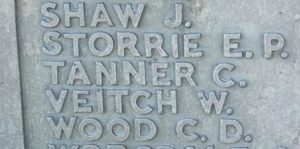Berriew is a village and community in the ancient county of Montgomeryshire, situated on the Montgomeryshire Canal and the River Rhiw near its confluence with the River Severn, some four miles south of Welshpool off the A483 main road. The community also includes the nearby village of Garthmyl, as well as several country estates, notably Vaynor Park, Glansevern Hall and Gardens, and Garthmyl Hall. The men of the district who fell during the Great War are commemorated by the Lych Gate which stands at the entrance to St. Beuno’s Church, inside of which is a plaque with the names of the 24 local men who fell. There is also an addition plaque inside the Lych Gate to commemorate the local men who fell during World War Two. Many thanks to John Turner for the photos of the WW2 memorial.

The Great War, 1914-1918
John Martin Andrew, Private, 9617, Worcestershire Regiment. John, known as Martin, was the son of John and Mary Andrew, of Camp, Berriew. He worked as a servant at Maesmawr Farm, Caersws prior to enlisting at Worcester into the Worcestershire Regiment at some time prior to the war. Martin embarked for France on 20 September 1914, as a draft for the 2nd Battalion, Worcestershire Regiment, which was attached to 5 Brigade, 2nd Division. The division had taken part in the Battle of Mons, and during the great retreat fought at the Affair of Landrecies, the Rearguard Actions of Villers-Cotterets, and at the Battle of the Marne where the German offensive was stopped. The Germans retreated north, and the BEF advanced, fighting at the Battle of the Aisne. The 2nd Division was then moved to Flanders with the BEF, and fought at the First Battle of Ypres, where the German sweep through Flanders was stopped. The 2nd Division remained in Flanders throughout the first winter of the war. In 1915 the division took part in the Battle of Festubert, and in September fought at the Battle of Loos, and subsequent Action of Hohenzollern Redoubt. On 20 December 1915 the 2nd Worcester’s transferred to 100 Brigade of the newly arrived 33rd Division. The Division saw its first major action during the Battles of the Somme, from July 1916 onwards. The following year it moved north and fought at the Battle of the Scarpe and at Bullecourt, before heading to Ypres, and fighting at the Menin Road and at Polygon Wood. The division was still in Flanders when the German Spring Offensive hit on 9 April 1918, and the 2nd Worcester’s, in billets in Izel-les-Hameau, was summoned to the front, reaching the area of Caestre-Neuve Eglise on 11 April. On the following afternoon the battalion was attacked and saw heavy fighting over the coming days. John was killed in action during another German attack on 17 April 1918. The 33-year-old has no known grave and is commemorated on the Ploegsteert Memorial, Belgium.
Richard Charles Benyon, Gunner, 189728, Royal Field Artillery. Richard was the son of John and Eliza Benyon, of Keel Cottage, Berriew. He worked as a Grocer prior to the war, and had married Amelia Evans, of Welshpool, at Stockport in 1911. The couple then resided at Ruabon, where their two children were born. Richard enlisted into the Royal Field Artillery at Liscard following the outbreak of war, and was posted to France with B Battery, 83rd Brigade, Royal Field Artillery, which was attached to the 18th (Eastern) Division. The Division saw its first major action during the opening of the Somme offensive in July 1916. The Division fought at the Battle of Bazentin, where it captured Trônes Wood, and moved on to the Battle of Delville Wood. In October it took part in the Battle of the Ancre Heights, capturing Schwaben Redoubt, and helped capture Regina Trench. The Division then fought at the Battle of the Ancre, and during the subsequent Operations on the Ancre, before spending the winter on the Somme. In March 1917 it followed the German Retreat to the Hindenburg Line, and in May took part in the Third Battle of the Scarpe, which was part of the Arras Offensive. July 1917 saw the Division at Ypres, where they took part in the Battle of Pilckem. Richard was killed in action just prior to the launching of the battle, probably by counter-battery fire, on 24 July 1917. The 29-year-old has no known grave and is commemorated on the Ypres (Menin Gate) Memorial, Belgium. Within months of his death, his widow had remarried, to Alfred Greasley, of Ruabon. His foster brother, Lawton Hall Jones, also fell during the war.
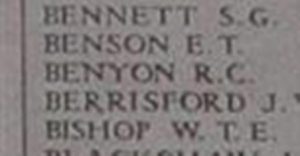
Albert Ellis, Private, 39149, South Wales Borderers. Albert was the son of John and Mary Ann Ellis, of Peny Park, Berriew. He worked as a Gamekeeper prior to the war. Albert enlisted at Welshpool into the 3/1st Battalion, Montgomeryshire Yeomanry, and was posted to Park Hall Camp, Oswestry for training. Albert was posted to France early in 1916, and was transferred to the 1st Battalion, South Wales Borderers, which was attached to 3 Brigade, 1st Division. The Division had wintered in the Loos sector, holding the line at Maroc, following the closure of the Battle of Loos the previous year. At the beginning of July, the 1st Division moved south to the Somme sector and by 10 July had reached Albert. The Division then moved into positions north of Mametz Wood, near Bazentin-le-Petit, and from there launched its first attacks on the Somme, during the Battle of Bazentin. The Division then took part in more heavy fighting supporting the Australian assault on Pozieres, and at the end of July moved into reserve at Millencourt, to rest and rebuild. In the middle of August, the Division moved back into the fray at Bazentin-le-Petit, before having another brief rest before joining the terrible fighting for High Wood. On 5 September the 1st SWB took over trenches facing High Wood, and on 8 September 1916 the 1st SWB moved forwards to support an assault by the 2nd Welsh and Gloucester’s on High Wood. The attacking troops suffered heavy losses, with many falling casualty to their own artillery, which was falling short, before being forced to withdraw. Albert was killed in action at some time during the days fighting. The 29-year-old has no known grave and is commemorated on the Thiepval Memorial, France.
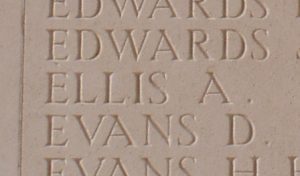
Arthur Daniel Evans, Private, 33079, Royal Welsh Fusiliers. Arthur was the son of Evan and Frances Evans, of Fronheilog, Fron, Garthmyl. He worked as a labourer prior to enlisting into the Royal Welsh Fusiliers at Welshpool on 27 July 1915, and was posted to Wrexham prior to being sent to the 3rd Battalion, Royal Welsh Fusiliers, at Litherland Camp, Liverpool for training. On 28 November 1915, Arthur embarked for France and was posted to the 9th Battalion, Royal Welsh Fusiliers, which was attached to 58 Brigade, 19th (Western) Division. Arthur joined the battalion in Northern France on 18 December, just prior to it moving back into the front-line in the infamous Boar’s Head sector. On the following day the 9th RWF relieved the 7th South Lancs in the front line to begin a routine tour. The trenches were found to be in a terrible state, so the men began repairs on the parapets immediately, as well as burying four dead soldiers the previous occupants had left behind. There were not enough dug-outs to house the men safely, so work also began on digging more during the afternoon. On the following day, 20 December 1915, Arthur became one of three men killed by an enemy sniper in a short spell, just two days after joining the battalion. Arthur would have been buried just behind the trench by his comrades, but the grave of the 30-year-old was lost during further fighting in the area, and he is commemorated on the Loos Memorial, France.
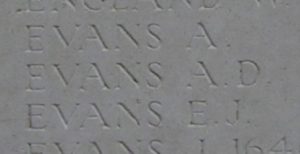
Llewelyn Langridge Evans, Private, 1776, Welsh Regiment. Llewelyn was the son of Richard and Margaret Evans, of Rhiew Villa, Berriew. He had moved to Cilfynydd prior to the war to work as a coal miner, but soon afterwards enlisted into the Welsh Regiment at Swansea. He had left the army prior to the outbreak of war, and was an army reservist. Llewelyn was mobilised at the outbreak of war and on 30 November 1914 was drafted out to France, joining the 2nd Battalion, Welsh Regiment, which was in Flanders attached to 3 Brigade, 1st Division. The Division had suffered heavy casualties during the retreat from Mons to the Marne, fighting a famous action at Chivy Ridge, where William Fuller of the 2nd Welsh had become the first Welshman to win the VC during the war. The Division then moved to Ypres with the BEF and helped hold the city during the First Battle of Ypres, suffering terrible casualties at Gheluvelt. Llewelyn was among a draft of 300 men who joined up with the 2nd Welsh in billets at Outtersteene on 3 December, where it was resting following its previous efforts. On 20 December the 3rd Brigade moved from Outtersteene through Bethune, and on the following day took over a section of front line at Festubert and during the afternoon the Brigade launched an attack on the German lines near the village. The assault failed, but had marked a particularly unpleasant spell in the trenches for the 2nd Welsh over the coming weeks. On 20 January 1915 the 2nd Welsh was enjoying a relatively peaceful day in the line near Givenchy, when Llewelyn was killed, and another man wounded. The Regimental Goat was the most prominent days casualty in the war diary, dying of heart failure in the afternoon and being buried on the bank of the La Bassée Canal. Llewelyn was just 18 years old when he was killed on 20 January 1915. He has no known grave and is commemorated on the Le Touret Memorial, Richebourg-L’avoue, France.
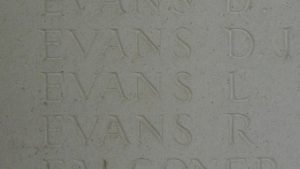
Cecil Ewart Griffiths, Private, 285129, Monmouthshire Regiment. Cecil was the son of Henry and Jane Griffiths, of The Cottage, Pentre Llivior, Berriew. He was a golf professional prior to the war. Cecil enlisted into the 7th Battalion, Royal Welsh Fusiliers at Newtown on 5 October 1914. The battalion was a Territorial unit, which mobilised for war at Newtown in August 1914, as part of North Wales Brigade, Welsh Division and moved to Conway until the end of the month, before moving to Northampton. In December the Division moved to Cambridge and then in May 1915 to Bedford, where the Division was numbered and the formation became 158 Brigade, 53rd (Welsh) Division. On 19 July 1915 the entire Division sailed from Devonport for Imbros and on 9 August 1915 landed at Suvla Bay. The infantry moved off the beaches into the bush, but due to a lack of maps and no knowledge of the terrain, many of the units became disorientated, and the situation became chaotic. Once the fighting dies down, the troops became bogged down into a stalemate, but as winter came conditions became abysmal, with torrential rain followed by snow. Cecil became ill, suffering from exposure, and was evacuated off the Peninsula in November, being taken to Malta before being sent home on the Hospital Ship Carisbrook Castle and was taken to the 2nd Western General Hospital in Manchester, where he was treated for trench feet and rheumatism. After recovering from his ill health, Cecil embarked at Southampton for France on 13 June 1917 and was sent to the Infantry Base Depot at Rouen. On 24 June he was transferred to the 1st Battalion, Monmouthshire Regiment, but was then posted to B Company, 2nd Battalion, South Wales Borderers. The battalion was attached to 87 Brigade, 19th (Western) Division and had suffered terrible losses during the Battle of Arras. Cecil joined the battalion on the Canal Bank at Boesinghe, where the Division had relieved the 38th (Welsh) Division temporarily, so that it could train for the forthcoming Third Battle of Ypres. He joined the battalion at L Camp, in Crombeek Wood on 12 July. The battle opened on 31 July 1917, and the 29th Division remained in reserve while the initial assaults took place. On 14 August the 2nd SWB moved into support positions near Saules Farm, and forded the flooded Steenbeek on the following night, before readying to assault Langemarck. At 04.45 on 17 August 1917 the 2nd SWB assaulted the strongly held ruins of Langemarck, capturing all its objectives and taking a large number of prisoners and munitions. Cecil was badly wounded during the assault, suffering gunshot wounds to his face, and was invalided back home over the coming days to the 5th Northern General Hospital at Leicester. He died there of severe wounds to his face and septicaemia on 25 August 1917, aged 23. His remains were conveyed home, and Cecil was buried in St. Beuno’s Churchyard, Bettws Cedewain, four days later.
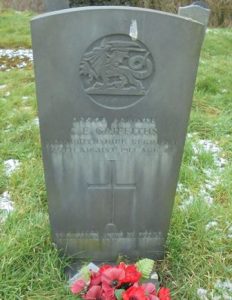
John Kinsey Griffiths, Private, 203047, Royal Welsh Fusiliers. John was the son of John and Harriet Griffiths, of Berriew Mill, Berriew. He enlisted at Newtown into the Montgomeryshire Yeomanry, and was probably posted to Park Hall Camp, Oswestry for his basic training. He was then transferred to the 4th Battalion, Royal Welsh Fusiliers, and was posted to France, probably in the summer of 1917, joining the 1/4th Battalion, Royal Welsh Fusiliers, which was the Pioneer Battalion to the 47th (2nd London) Division. John possibly arrived in France in time to take part in the Battle of Messines, and then in November 1917 the Division fought at the Battle of Cambrai. In March 1918 the Division was situated near St. Quentin, and faced the German Spring Offensive here on 21 March, seeing heavy fighting during the rear-guard actions which followed. In August 1918 the British attacked on the Somme, and the Division took part in the great offensive which broke the Hindenburg Line and ultimately won the war. After the Armistice the 4th RWF was billeted at Bizencourt, NE of Tournai, where the men were demobilised and sent home. John had survived the war, but it must have taken its toll on his health, as he eventually died as a result of his wartime services on 23 April 1920, aged 23. John is buried in Oswestry General Cemetery. He is not commemorated on the Berriew war memorial.
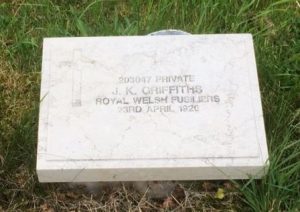
John Waring Griffiths, Private, 21242, King’s Shropshire Light Infantry. John was born in Berriew in 1880, the illegitimate son of Sarah Jane Griffiths. He was raised by his Uncle, Thomas Griffiths, at Penysarn, Berriew, where he worked as a farm labourer. His mother had by now married John Waring, and lived at 1, Quarry Place, Welshpool. John enlisted at Welshpool into the King’s Shropshire Light Infantry soon after the outbreak of war. John embarked for France in the Winter of 1916, and was posted to the 1st Battalion, King’s Shropshire Light Infantry, which was attached to 16 Brigade, 6th Division. The Division had seen heavy fighting on the Somme that summer, before being relieved and the 1st KSLI spent most of December 1916 billeted in Bethune before taking over a section of the line near Givenchy. The battalions of the Division then began the usual routines of trench rotation, four days in support, four in the front line and four in reserve, over the coming weeks, moving to the Vermelles sector. By the beginning of April 1917, the 1st KSLI was in the line SE of Loos. To the south the Canadian launched an assault on Vimy Ridge on 9 April, and the Germans in front of the 1st KSLI withdrew and 16 Brigade advanced, taking over the high ground between the Double Crassier to the Lens to Bethune road. The 1st KSLI remained in support, ready to move forward and on 16 April moved out of Loos into the new front line. At 13.30 on 17 April 1917 the battalion attempted to advance further, and a fierce bomb fight ensued, forcing the battalion to withdraw. John was killed in action during the fighting that day. The 37-year-old was originally buried on the battlefield, but after the war his grave was exhumed, and he was re-buried in Dud Corner Cemetery, Loos, France. John is not commemorated on the Berriew war memorial, but at nearby Welshpool.
John Henry Harding, Private, 12697, Lincolnshire Regiment. John was the son of Thomas and Jane Harding, of Wyle Cop, Berriew. He was living at Dulwich, Surrey when war broke out, and enlisted at Kingston into the 7th Battalion, Lincolnshire Regiment. The battalion had formed at Lincoln in September 1914, moving to Wool to join 51 Brigade, 17th (Northern) Division, moving to Winchester in June 1915 to complete its training. On 14 July 1915 the Division landed at Boulogne and moved into the Ypres Salient for trench initiation. On 29 July John’s battalion moved into the front line for the first time to begin its first routine tour, under instruction of a battalion of the 46th (North Midland) Division. On 6 October the Division moved out of the line to billets at Eecke, to rest, and two weeks later moved back into the front line at Ypres, near Maple Copse. On 10 November the Division relieved the 6th Division in the Hooge Sector, and spent the coming weeks rotating between tours in the line and reserve positions in the Ypres Ramparts. This spell turned out to be a particularly nasty one, with both sides raining down artillery fire upon the other at regular intervals. On 29 November 1915 John was in the front line with the battalion when he was killed by shrapnel, just prior to the battalion being relieved. The 24-year-old was originally buried in Menin Road North Military Cemetery, but in 1919 all of the graves in the cemetery were exhumed, and re-buried in Menin Road South Military Cemetery, Belgium. The graves concentration record for John’s re-burial interestingly states that his was among a number of erected crosses that were found with no remains, so his grave is marked by a Special Memorial, as his body does not lie beneath it.
Clement Hibbott, Private, 356019, Royal Welsh Fusiliers. Clement was born in Welshpool in 1890, the son of David Hibbott and Alice Mary Hibbott (nee Pryce). His father was a cabinet maker, and by 1891 had moved the family to Leek, in Staffordshire. By 1911 the family had moved back to Station View, Welshpool. Clement worked as a gardener at Powis Castle, and then at Glansevern Hall prior to the war. Clement enlisted into the 7th Battalion, Royal Welsh Fusiliers at Welshpool on 29 August 1914. The battalion was a Territorial unit, which mobilised for war at Newtown in August 1914, as part of North Wales Brigade, Welsh Division and moved to Conway until the end of the month, before moving to Northampton. In December the Division moved to Cambridge and then in May 1915 to Bedford, where the Division was numbered and the formation became 158 Brigade, 53rd (Welsh) Division. On 19 July 1915 the entire Division sailed from Devonport for Imbros and on 9 August 1915 landed at Suvla Bay. The infantry moved off the beaches into the bush, but due to a lack of maps and no knowledge of the terrain, many of the units became disorientated, and the situation became chaotic. After the worst of the fighting had calmed down, the campaign settled into a stalemate, but as winter came the conditions became unbearable, with the unsanitary conditions, torrential rain and snow bringing disease to the men in the trenches. Clement suffered frostbite towards the end of the campaign and was evacuated aboard the Hospital Ship Sudan hospital in Malta, before returning to England aboard the Hospital Ship Formosa. It was almost a year before Clement was fit enough to return to duty, and he embarked at Southampton for Egypt on 25 February 1917. He re-joined his old battalion on 24 March, just in time to take part in the First Battle of Gaza on 26 March 1917, where the EEF launched its first offensive against the coastal city of Gaza, which guarded the road to Jerusalem. Initial gains during the day were lost when the assaulting divisions lost touch with each other and communication broke down when a thick fog cloaked the battlefield. A second attempt to force Gaza was launched on 17 April, which also failed, and the EEF suffered a change in leadership, with Sir Edmund Allenby assuming command, before being re-organised, and a third offensive was launched against a wider front from Beersheba to Gaza on 31 October 1917. This time the Turkish defences were breached, and the road to Jerusalem now lay open and the EEF began to advance north. Clement had been wounded during the fighting of 31 October, and was evacuated to the 31st General Hospital at Port Said, where he died of multiple gunshot wounds to his back, ribs and thorax on 18 November 1917. The 27-year-old is buried in Port Said War Memorial Cemetery, Egypt.
Alfred Jones, Private, 5906, Wiltshire Regiment. Alfred was born at Liverpool in 1879, the son of David Jones, but resided in Berriew prior to the war. He enlisted at Preston into the 1st Battalion, Wiltshire Regiment at some time prior to the war, under the alias of Alfred Morris. The battalion was at Tidworth, attached to 7 Brigade, 3rd Division, and landed at Rouen on 14 August 1914, before moving to Mons with the BEF, and the 1st Wiltshire’s took up positions north of Ciply, facing Mons. The battalion watched as the Germans struck the Allied positions at Mons on 23 August and on the following the day the Germans struck the Wiltshire’s line at Ciply. Under extreme pressure and vastly outnumbered, the BEF was forced to withdraw south, and over the coming days took part in an epic retreat southward to the River Marne, before launching a combined offensive with the French which stopped the German advance, forcing the Germans back to the River Aisne, where another large battle was fought. The BEF then moved north to Flanders, and by 9 October 1914 the 1st Wiltshire had reached Pernes and went into billets. The battalion did not move back into the front line until 12 October, when it came into contact with the Germans on the left bank of the River Loisne. By now Alfred had been posted as missing on or since 10 October 1914. His death was later officially recorded as having taken place on the former date. The 35-year-old has no known grave and is commemorated on the Le Touret Memorial, Richebourg-L’avoue, France. Alfred is not commemorated on the Berriew war memorial.
Ellis William Jones, Private, 1041, Royal Welsh Fusiliers. Ellis was born at Berriew, and lived with his unmarried wife, Emma Watkins, at Pool Road, Berriew. He enlisted at Welshpool into the 7th Battalion, Royal Welsh Fusiliers. The battalion was a Territorial unit, which mobilised for war at Newtown in August 1914, as part of North Wales Brigade, Welsh Division and moved to Conway until the end of the month, before moving to Northampton. In December the Division moved to Cambridge and then in May 1915 to Bedford, where the Division was numbered and the formation became 158 Brigade, 53rd (Welsh) Division. On 19 July 1915 the entire Division sailed from Devonport for Imbros and on 9 August 1915 landed at Suvla Bay. The infantry moved off the beaches into the bush, but due to a lack of maps and no knowledge of the terrain, many of the units became disorientated, and the situation became chaotic. The Division was eventually evacuated from Gallipoli in December 1915, moving to Egypt to join the EEF, and helped guard the Suez Canal before taking part in operations to drive the Turks out of the Sinai. Ellis became ill soon after arriving in Egypt, and he died of typhoid at Cairo Choubra Military Hospital on 26 April 1916. He is buried in Cairo War Memorial Cemetery, Egypt.
Geoffrey Brian Jones, Second Lieutenant, Welsh Regiment. Geoffrey was the son of James Richard and Mary Louisa Jones, of Trwsllewelyn, Garthmyl. He enlisted into the Honourable Artillery Company, and was commissioned from the regiment into the South Wales Borderers on 30 April 1918. After embarking for France, Geoffrey was posted to the 13th Battalion, Welsh Regiment, which was holding the line north of Albert, attached to 114 Brigade, 38th (Welsh) Division. The Division had taken over these positions, along Bouzincourt Ridge, at the end of March 1918, relieving the battered 2nd and 47th Divisions. It held this sector, carrying out minor operations and trench raids, over the coming months, before taking part in the great offensive of 21 August 1918, and began its advance towards the Hindenburg Line. Over the coming days the Division advanced along the old Somme battlefields, capturing Mametz and Delville Wood, before seizing the villages of Morval and Sailly-Saillisel and crossing the Canal du Nord whilst advancing towards the Hindenburg Line. At 05.20 on 18 September 1918, 114 Brigade launched an assault on the Gouzeaucourt defensive system. The 13th Welsh assaulted the German held African and Heather Trenches, south-west of Gouzeaucourt. The going was made difficult by the wet ground and enemy shellfire, but the battalion managed to attain its objectives, capturing a large number of prisoners throughout the day. Geoffrey was posted as missing, believed killed during the days fighting. The body of the 22-year-old was later found, and he was buried in Gouzeaucourt New British Cemetery, France.
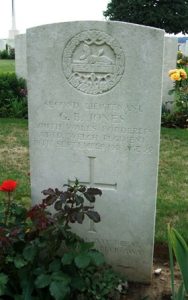
Harold David Jones, Private, 73292, Royal Welsh Fusiliers. Harold was the son of William and Alice Jones, of Brooks Smithy, Berriew. The family had moved to 3, Berry Square, Dowlais prior to the war, and Harold enlisted at Merthyr into the Royal Welsh Fusiliers in 1917. He was drafted to France in the autumn of 1917, initially to join the 9th Battalion, Royal Welsh Fusiliers, but was instead posted to the 14th Battalion, Royal Welsh Fusiliers, which was in the Armentieres sector attached to 113 Brigade, 38th (Welsh) Division. The Division had been transferred to the Sailly-sur-la-Lys sector in September 1917, and remained in the area over the winter before being moved to positions north of Albert, at Bouzincourt Ridge, at the end of March 1918, relieving the battered 2nd and 47th Divisions. It held this sector, carrying out minor operations and trench raids, over the coming months, before taking part in the great offensive of 21 August 1918, and began its advance towards the Hindenburg Line. Over the coming days the Division advanced along the old Somme battlefields, capturing Mametz and Delville Wood, before seizing the villages of Morval and Sailly-Saillisel and crossing the Canal du Nord whilst advancing towards the Hindenburg Line. At 05.20 on 18 September 1918, 113 Brigade launched an assault on the Gouzeaucourt defensive system. The 14th RWF assaulted the German held African Trench and African Support, south-west of Gouzeaucourt. The going was made difficult by the wet ground and enemy shellfire, and the battalion struggled until artillery support enabled them to capture a section of African Trench. Harold was killed in action during the fighting that day. The 19-year-old has no known grave and is commemorated on the Vis-en-Artois Memorial, Haucourt, France.
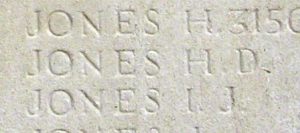
Lawton Hall Jones, Private, 291432, Royal Welsh Fusiliers. Lawton was born at Berriew on 27 July 1890, the illegitimate son of Margaret Jones. He was then fostered by Eliza Benyon, of Keel Cottage, Berriew. Lawton had spent six months in Ruthin Jail in 1911, and upon his release worked as a labourer. He enlisted at Welshpool into the 3/7th Battalion, Royal Welsh Fusiliers on 7 December 1915, and was initially placed on the Army Reserve. Lawton was mobilised at Wrexham on 13 February 1916 before being posted to Oswestry to join the battalion for his basic training. On 10 December 1916 Lawton embarked for Egypt, joining the 1/7th Battalion, Royal Welsh Fusiliers, which was attached to 158 Brigade, 53rd (Welsh) Division. The Division had been evacuated from Gallipoli in December 1915, moving to Egypt to join the EEF, and helped guard the Suez Canal before taking part in operations to drive the Turks out of the Sinai. The EEF then turned its attention onto driving the Turks out of Palestine, and on 26 March 1917 launched its first offensive against the coastal city of Gaza, which guarded the road to Jerusalem. Initial gains during the day were lost when the assaulting divisions lost touch with each other and communication broke down when a thick fog cloaked the battlefield. Lawton was killed in action during the fighting that day. The 28-year-old is buried in Gaza War Cemetery, Gaza. His foster brother, Richard Charles Benyon, also fell during the war.
John Graham Lewis, Private, 203615, Manchester Regiment. John was the son of John and Elizabeth Lewis, of Gwaunnydd, Berriew. He worked as a Draper prior to the war. John enlisted at Manchester into the 2/6th Battalion, Manchester Regiment. The battalion was formed in Manchester, joining 199 Brigade, 66th (East Lancs) Division, and remained in Lancashire until about May 1915 when the Division moved to the Crowborough area. During March 1916 the Division moved to Colchester and in February 1917 landed in France, moving to the St. Floris sector for trench initiation. The Division then held the Cambrin Left Sector until 21 June, when it was relieved by the 2nd Division and moved to Dunkirk, before taking up positions on the Flanders coast, to prepare for a possible offensive in case of a break-through at Ypres. When the Third Battle of Ypres became bogged down in the mud, the 66th Division was among a number transferred to the Ypres Salient, and took part in the Battle of Poelcapelle. The Division wintered in the Ypres Salient, then at the beginning of February 1918 moved south to positions near Harbonnières, on the Amiens to St. Quentin road. The Division moved east, taking over positions in the Villeret Sector, and its infantry battalions began their regular rotational spells in the trenches. On 21 March 1918 the 2/6th Manchester’s were in reserve lines at Villeret when the Germans opened up their massive artillery bombardment all along the section of front line running from Croisilles to la Fère. The bombardment was followed up by an infantry assault, comprising thousands of highly skilled stormtroopers, who broke the Allied lines. Over the coming days there was terrible fighting as the 66th Division was forced to withdraw, reaching Harbonnières again on 27 March, before carrying on the withdrawal to Hangard and Gentelles. John was killed in action at some time between 21 March and 31 March 1918, although the officially accepted date for his death is the latter. The 30-year-old is buried in Villeret Old Churchyard, France.
Edwin Edward Lloyd, Private, 11652, Somerset Light Infantry. Edwin was the son of Richard Lloyd and Margaret Ann Lloyd (nee Jones), of Llivior Gate, Berriew. By 1911 his mother had died, and Edwin was lodging at 98, Mardy Road, Mardy, where he worked as a coalminer. He enlisted at Bargoed into the 7th Battalion, Somerset Light Infantry soon after the outbreak of war. The battalion had formed at Taunton on 13 September 1914, moving to Woking to join 61 Brigade, 20th (Light) Division. During February 1915 the Division moved to Witley Camp, near Godalming and in April 1915 to Larkhill, before landing in Boulogne on 24 July 1915. The Division moved to positions around Rossignol, for further training, before moving to Armentieres and into the Fleurbaix Sector for trench familiarisation and training. When the Battle of Loos was launched on 25 September 1915 the Division fought a diversionary attack towards Fromelles. In February 1916 the division moved north, into the Ypres Salient, and fought at the Battle of Mount Sorrel alongside the Canadian Corps. Towards the end of July 1916 the Division began to move south, into the Somme sector, to join the Somme offensive, taking over trenches at White City and Mountjoy Dugouts by 27 July and Edwin’s battalion began work on wiring parties. By 14 August his battalion had moved into positions at Serre with the Division and was relieved after two relatively peaceful days, before the division moved slightly south, to Carnoy, the took over positions in the front line at Guillemont and from 1 September became embroiled in heavy fighting at Trônes Wood and Leuze Wood. Edwin’s battalion then had a brief rest before re-joining the action, and on the night of 15/16, September moved forwards through the ruins of Ginchy to positions facing the German line in front of Lesboeufs, and at 09.35 on 16 September 1916 launched an assault on the German positions, seizing their front-line trenches. Edwin was killed in action during the fighting that day. The 36-year-old has no known grave and is commemorated on the Thiepval Memorial, France. Edwin is not commemorated on the Berriew war memorial.
John Llywarch, Lance Sergeant, 1639, Monmouthshire Regiment. John was the son of John and Mary Llywarch, of Oerle, Berriew. He enlisted into the 24th Foot (South Wales Borderers) at Welshpool on 14 November 1893, and served for almost ten years before leaving the army and returning to Berriew. In the summer of 1902, John married Lucy Evans, of Manafon, and by 1911 the couple were living at 8, Howells Terrace, Monmouth, where John worked as a rural postman. As an Army Reservist, John was mobilised at the outbreak of war, and joined the 2nd Battalion, Monmouthshire Regiment. The battalion was a Territorial unit, which mobilised at Pontypool on 4 August 1914, moving to Pembroke Dock with the Welsh Division. The 2nd Monmouth’s then moved to Oswestry and then Northampton, before leaving the Welsh Division and landed at Le Havre on 7 November 1914, joining 12 Brigade, 4th Division at Le Bizet, near Ploegsteert. The 2nd Monmouth’s spent the next weeks attached to other battalions, gaining experience in trench warfare in trenches which had been built above ground, due to high water levels, and consisted of raised parapets of sandbags, wood and tin sheets. Some units of 4th Division took part in the famous Christmas Truce, in their trenches near Ploegsteert Wood, but there is no mention of this in the Monmouth’s war diary. The 2nd Monmouth’s enjoyed a relatively quiet first five months in the trenches, suffering some 170 casualties, but that came to an end in April 1915, when the 4th Division moved north to Ypres, reaching Vlamertinghe by 30 April, to join the desperate defensive action of the Second Battle of Ypres. On 1 May the 2nd Monmouth’s crossed the Yser Canal and went into Divisional reserve at La Brique, where it came under the heaviest artillery bombardment the men had yet seen, followed by a cloud of asphyxiating gas. John was wounded around this time, and was evacuated to No 12 General Hospital at Rouen, where he died of his wounds on 9 May 1915. The 38-year-old is buried in St. Sever Cemetery, Rouen, France. John is not commemorated on the Berriew war memorial.
John Henry Morgan, Private, 55525, Royal Welsh Fusiliers. John was the son of John and Sarah Morgan of Penybryn, Abermule. He enlisted at Welshpool into the Montgomeryshire Yeomanry, and was posted to Park Hall Camp, Oswestry for training. John probably embarked for France in the Spring of 1917, and was posted to the 17th Battalion, Royal Welsh Fusiliers, which was holding the Canal Bank sector at Boesinghe, attached to 115 Brigade, 38th (Welsh) Division. The Division had moved there following its epic assault on Mametz Wood the previous year, and its infantry battalions had been carrying out the normal pattern of rotation in the trenches, four days in the front, four in support and four in reserve, whilst also working on trench improvement, digging new trenches, and also carrying out regular patrols and trench raids. On 31 July 1917 the Division launched its famous assault on the Pilckem Ridge, capturing Iron Cross and reaching its objective of the Steenbeek, then played a supporting role in the Battle of Langemarck. The Division was transferred to the Sailly-sur-la-Lys sector in September, and remained in the area over the winter. On 1 March 1918 the 17th RWF relieved the 2nd RWF to begin another routine tour in the Wez Macquart Sector, and on the following day launched a trench raid against the Germans, suffering thirteen men wounded. The battalion remained in the front line over the coming days, with working parties busy repairing and improving the trenches. John was killed in action here on 6 March 1918, aged 20. He is buried in Erquinghem-Lys Churchyard Extension, France.
Edward Rhys Morris, Leading Cooks Mate, M/925(Ch), Royal Navy. Edward was born on 10 June 1890, the son of Pheel Morris and Martha Morris (nee Beadles), of Belle Vue, Berriew. He worked as a Baker’s Assistant prior to enlisting into the Royal Navy on 15 April 1909, and was posted to HMS Pembroke I, at Chatham, for training. His first posting was aboard HMS Hawke, before serving aboard HMS Encounter then HMS Drake and HMS Cambrian. Just days before the outbreak of war, Edward was posted aboard the armoured-cruiser HMS Euryalus, and he saw action aboard her during the Battle of Heligoland Bight and during ill-fated Gallipoli campaign, where Euryalus covered the landings at Cape Helles. The cruiser remained in the Mediterranean before being decommissioned at the end of 1917. On 9 August 1917 Edward was posted back to HMS Pembroke I, before being posted to the battleship HMS Royal Oak, which was attached to the Grand Fleet. HMS Royal Oak was anchored off Buntisland, in the Firth of Forth, when Edward fell whilst aboard her, and struck his head. He died of concussion at the RN Hospital, South Queensferry, West Lothian, Scotland, on 1 July 1918, aged 28. His remains were brought home for burial in St. Beuno’s Churchyard, Berriew. His brother, Walter, had been killed in 1915.
Walter James Morris, Private, 11031, Leicestershire Regiment. Walter was born on 26 September 1892, the son of Pheel Morris and Martha Morris (nee Beadles), of Belle Vue, Berriew. By 1911 he was living at 19, Bismarck Road, Wolverhampton, where he worked as a Dairyman. Walter enlisted into the 3rd Battalion, Leicestershire Regiment at Wolverhampton on 14 September 1912, becoming a Special Reservist with the regiment. He was mobilised soon after the outbreak of war and was posted to France among a number of drafts for the 1st Battalion, Leicestershire Regiment, disembarking in France on 9 November 1914, before joining the battalion at Le Touquet, where it was attached to 16 Brigade, 6th Division. Walter had missed the First Battle of Ypres, so his first experience of life in the trenches was relatively peaceful for the coming weeks. The battalion began to rotate in the line at Rue du Bois, with spells in billets at Armentieres. On 24 January 1915 Walter was admitted to Hospital at Erquinghem, suffering from tonsilitis, and was then sent to Hospital at Bethune. He re-joined the 1st Leicester’s a week later. On 15 March 1915 the battalion entrained for Vlamertinghe, and was placed in reserve for an assault on St. Eloi, but was not needed, so returned to Armentieres, then to its positions at Rue du Bois. The battalion remained here with the 6th Division until moving back into the Ypres Salient at the beginning of June 1915, and soon afterwards, saw heavy fighting in the Action of Hooge during June 1915. The Division launched an assault against Hooge on 9 August, beginning a short period of intense fighting, before moving slightly north to the Canal Bank sector. At the beginning of December 1915, the 1st Leicester’s moved out of the line to billets in Houtkerque to rest, then on 18 December moved back into the front line at Potijze, to begin another routine spell in the trenches, which soon turned into one of the deadliest spells suffered by the battalion so far. On 19 December the Germans began venting hundreds of gas cylinders, which created clouds of gas which drifted over the 6th Divisions front line. The Germans the launched a massive artillery bombardment onto the divisional area, which continued over the coming days. Walter was killed in action at Wieltje on 21 December 1915, aged 23. He is buried in White House Cemetery, St. Jean-Les-Ypres, Belgium.
Archie Owen, Private, 88790, The King’s (Liverpool Regiment). Archie was the son of Herbert Henry and Elizabeth Owen, of Saddler, Berriew. He enlisted into the army at Wrexham, and was posted to France at the end of 1917, joining the 1/7th Battalion, The King’s (Liverpool Regiment), which was attached to 165 Brigade, 55th (West Lancs) Division. Archie was probably among a draft of 130 men who joined the battalion at Crépy, near Péronne, in January 1918, where the Division had moved to undergo a period of rebuilding and intensive training, following heavy losses at Cambrai, before moving back into the front line, and the Division relieved the 42nd (East Lancashire) Division in the front line at Givenchy and Festubert on 15 February. The battalions of the division began the usual routines of trench line, rotating between the front line, support line, and then going into reserve, over the coming weeks. On 21 March 1918 the Germans launched the first phase of their Spring offensive to the south, along a length of the Western Front running from Croisilles to La Fère. This marked a suspiciously quiet period in Flanders, where no real German activity could be noted, but the men knew a storm was brewing, as activity behind the lines began to increase. On 9 April the second phase of the German offensive was launched along the Lys Valley, and the 55th Division, holding a sector at Festubert, was hit hard at 04.10 on the opening day. Soon afterwards the 1/7th Liverpool’s, in reserve, received news that the front line had been broken, and by noon the Germans came into sight and the battalion was hurled into desperate fighting, mowing down scores of Germans at Le Plantin North, but the positions on the right, at Le Plantin South and Windy Corner, had fallen and the battalion formed a defensive flank before beginning to withdraw. The Germans attacked again in great strength the following morning, 10 April 1918, and in the heavy fighting which followed, Archie was killed. The 19-year-old has no known grave, and is commemorated on the Loos Memorial, France.
John Pugh Owens, Private, 37435, Machine Gun Corps. John was born in Berriew in 1896, the son of Thomas and Edith Harriet Owens. By 1901 the family had moved to Brynymor, Tywyn. John enlisted at Tywyn into the 7th Battalion, Royal Welsh Fusiliers early in the war. He was posted to Park Hall, Oswestry for training, and after completing his training was posted to France, joining the 49th Company, Machine Gun Corps, which was attached to the 16th (Irish) Division. During December 1915 the Division moved to France and concentrated in the Bethune area. It saw its first major action during the Somme Offensive, at the Battle of Guillemont, and also fought at the Battle of Ginchy. By May 1917 the Division had moved to positions south of Ypres, taking part in the Battle of Messines, and then moved north, fighting at the Battle of Langemarck. The Division then moved to the Villers-Faucon sector over the winter, facing the Hindenburg Line. John’s Company was in the line near St. Emelie on 24 February 1918, firing a machine-gun barrage on the German strongpoint of Quennemont Farm, when John was killed, possibly by German artillery fire, which was very active during the day. The 21-year-old is buried in Villers-Faucon Communal Cemetery Extension, France. John is not commemorated on the Berriew war memorial, but on the Tywyn war memorial.
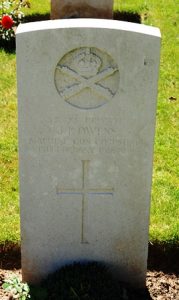
Henry Ellis Phillips, Private, 43746, Royal Welsh Fusiliers. Henry was the son of Benjamin Hudson Phillips and Elizabeth Phillips, of Temperance Hotel, Tregynon. He lived at The Revel, Berriew prior to the war, where he worked as a Butcher. Henry enlisted into the 3rd Battalion, Royal Welsh Fusiliers at Welshpool on 12 February 1916. He was initially placed on the Army Reserve, before being mobilised on 2 June 1916 and sent to Litherland Camp, Liverpool for training, after being rejected for the Royal Flying Corps. On 3 October 1916 Henry embarked for France, initially destined to join the 1st Battalion, Royal Welsh Fusiliers, but was instead posted from the 5th Infantry Base Depot to the 13th Battalion, Royal Welsh Fusiliers, which was at Ypres attached to 113 Brigade, 38th (Welsh) Division. The Division had moved to the Ypres Salient, taking over the Canal Bank sector at Boesinghe, following its epic assault on Mametz Wood during the Somme offensive. The infantry battalions of the Division then began carrying out the normal pattern of rotation in the trenches, four days in the front, four in support and four in reserve, whilst also working on trench improvement, digging new trenches, and also carrying out regular patrols and trench raids. On 31 July 1917 the Division launched its famous assault on the Pilckem Ridge, capturing Iron Cross and reaching its objective of the Steenbeek, then played a supporting role in the Battle of Langemarck. The Division was transferred to the Sailly-sur-la-Lys sector in September, and remained in the area over the winter before being moved to positions north of Albert, at Bouzincourt Ridge, at the end of March 1918, relieving the battered 2nd and 47th Divisions. On 21 April, 113 Brigade moved into the line, in readiness for an assault, to attempt to gain the high ground of Bouzincourt Ridge. As the men leapt over the top of their trenches on 22 April, they were immediately hit by concentrated machine-gun fire. The supporting artillery barrage proved inadequate, and many casualties were suffered, before the brigade was forced to withdraw. Henry was wounded during the attack of 22 April and was evacuated to the 3rd Canadian Stationary Hospital at Doullens, where he died of his wounds on 25 April 1918, aged 25. He is buried in Doullens Communal Cemetery Extension No. 1, France.
Thomas Phillips, Private, 60950, Royal Welsh Fusiliers. Thomas was the son of Thomas and Elizabeth Ellen Phillips, of Pontywynthrew, Berriew. He worked on his father’s farm prior to the war. Thomas married Alice Jones, of Llanfair Caereinion in 1915. At some time afterwards he enlisted into the Royal Welsh Fusiliers, and embarked for France in the autumn of 1917, joining the 13th Battalion, Royal Welsh Fusiliers, which was attached to 113 Brigade, 38th (Welsh) Division. The Division had been transferred to the Sailly-sur-la-Lys sector in September 1917, following heavy fighting at Ypres, and remained in the area over the winter before being moved to positions north of Albert, at Bouzincourt Ridge, at the end of March 1918, relieving the battered 2nd and 47th Divisions. On 21 April, 113 Brigade moved into the line, in readiness for an assault, to attempt to gain the high ground of Bouzincourt Ridge. As the men leapt over the top of their trenches on 22 April 1918, they were immediately hit by concentrated machine-gun fire. The supporting artillery barrage proved inadequate, and many casualties were suffered, before the brigade was forced to withdraw. Thomas was killed in action during the fighting that day. The 29-year-old is buried in Bouzincourt Ridge Cemetery, Albert, France.
Griffith Ellis Ridge, Private, 203111, Royal Welsh Fusiliers. Griffith was the son of Hugh and Margaret Ridge, of Llyndu Cottage, Meifod. He worked as a farm labourer at Keel prior to the war. Griffith enlisted into the Montgomeryshire Yeomanry at Welshpool on 21 September 1914 and was posted to Park Hall Camp, Oswestry before being transferred to the 4th Battalion, Royal Welsh Fusiliers on 17 December 1916. On 18 December 1916 Griffith arrived in France, joining No 5 Infantry Base Depot, at Rouen, and on 5 January 1917 was posted to the 1/4th Battalion, Royal Welsh Fusiliers, which was at Ypres, serving as the Pioneer Battalion to the 47th (2nd London) Division. Over the coming weeks, Griffith worked with the battalion at Railway Dugouts, but on 14 April was among three men wounded, suffering gunshot wounds to his arm, and was evacuated to hospital before returning to England for treatment. After recovering, he returned to No 5 Infantry Base Depot, and from there was posted to the 19th Battalion, Royal Welsh Fusiliers on 24 September 1917. The battalion was attached to 119 Brigade, 40th (Bantam) Division, and Griffith joined up with his new battalion in time to take part in the terrible fighting for Bourlon Wood, during the Battle of Cambrai. He was wounded at Bourlon Wood on 24 November, and hospitalised again, before re-joining the battalion. The 19th RWF was disbanded on 6 February 1918, and its men posted to other battalions. Griffith was posted to Hawke Battalion, 63rd (Royal Naval) Division, which was on the Somme. On 25 May 1918 Griffith was with Hawke Battalion, which was bivouacked at Engelbelmer, in Divisional Reserve, when their camp was hit by a dozen German shells, causing eleven casualties, and killing Griffith and another man. Griffith was 21-years-old when he was killed that day and is buried in Engelbelmer Communal Cemetery Extension, France.
William Charles Smith, Private, 291254, Royal Welsh Fusiliers. William was the son of Samuel Smith and Ruth Smith (nee Lewis), of Fron, Garthmyl. He worked as a bricklayer prior to the war. He enlisted at Newtown into the 3/7th Battalion, Royal Welsh Fusiliers on 22 November 1915, and was posted to Park Hall Camp, Oswestry for training. On 31 May 1916 William embarked at Devonport for Alexandria aboard the HT Kalyan, and disembarked on 11 June, joining the 1/7th Battalion, Royal Welsh Fusiliers on 16 June. The battalion was attached to 158 Brigade, 53rd (Welsh) Division, and had been evacuated from Gallipoli in December 1915, moving to Egypt to join the EEF, and helped guard the Suez Canal before taking part in operations to drive the Turks out of the Sinai. The EEF then turned its attention onto driving the Turks out of Palestine, and on 26 March 1917 launched its first offensive against the coastal city of Gaza, which guarded the road to Jerusalem. Initial gains during the day were lost when the assaulting divisions lost touch with each other and communication broke down when a thick fog cloaked the battlefield. William was posted as missing, believed killed in action, during the fighting that day. The 37-year-old has no known grave and is commemorated on the Jerusalem Memorial, Israel.

Arthur Edwin Tanner, Private, 54433, Royal Welsh Fusiliers. Arthur was the son of William and Emily Tanner, of Old Toll Gate, Garthmyl. He enlisted at Welshpool into the 3/1st Battalion, Montgomeryshire Yeomanry, and was posted to Park Hall, Oswestry for training. Arthur was then posted to France early in 1916, joining the 10th Battalion, Royal Welsh Fusiliers, which was attached to 76 Brigade, 3rd Division, and was holding the line at St. Eloi, near Ypres. The Division saw heavy fighting during the Actions of the Bluff in February 1916 and then at the Actions of the St Eloi Craters from 27 March to 16 April. Arthur probably joined the 10th RWF after one of these actions, due to heavy losses suffered by the battalion. The battalion continued to suffer during these months at St. Eloi, coming under a gas attack for the first time on 29/30 April. By the middle of June, the Division had moved out of the Ypres Salient to billets around Eperlecques, where intense training was carried out prior to moving to the Somme sector by 2 July. The main Somme offensive had opened on the previous day, and the 3rd Division was ready to enter the fray, bivouacking at Bronfay Farm by 9 July and on 13 July moved into the captured German lines at Montauban Alley. The 10th RWF took part in heavy fighting over the coming days, and on 19 July received orders for an assault on Delville Wood. Just after midnight the following day the battalion moved forwards and became caught in in terrible fighting within the wood, the fighting of such severity that two men of the battalion were awarded the Victoria Cross. On 25 July the shattered battalion was relieved and moved into reserve, and did not move back into the line until 17 August, when the battalion attacked Lonely Trench. On 23 August the Division moved out of the line to rest and moved to Noeux-les-Mines, near Loos. After a month there, the Division moved back into a rest area for further training before moving back south to the Somme and by 12 November took over trenches at Serre. On the following day, 13 November 1916, the Division launched an assault against the German positions at Serre. The 10th RWF reached Serre village, but the flanking battalions failed to keep up, and heavy losses were suffered, with almost 300 officers and men killed, wounded, or missing. Arthur was posted missing, believed killed in action during the assault on Serre that day. The 18-year-old has no known grave and is commemorated on the Thiepval Memorial, France.
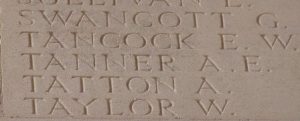
Alfred George Trow, Private, 19617, South Wales Borderers. Alfred was born at Guilsfield in 1875, the son of George and Jane Trow. By 1891 he was living at Felindre Mill, Berriew, where he worked as a cowman. Alfred married Jane Simmonds in 1900, and the couple lived at Pentre Llifior Cottage, Berriew for several years before moving to Abertillery, where Alfred gained work as a coalminer. He enlisted at Newport, Mon into the South Wales Borderers soon after the outbreak of war, and on 26 December 1915 embarked for France, joining the 1st Battalion, South Wales Borderers, which was attached to 3 Brigade, 1st Division. The battalion was in Loos, and had been playing host to a number of Royal Naval Petty Officers, who were gaining experience in the front line, whilst supplying working parties daily, improving and consolidating trenches. On 8 January 1916 the 1st SWB was relieved, and marched to Noeux-les-Mines before entraining for Lillers, and then marched to billets at Ferfay to rest. General Joffre, the French commander in chief, inspected the battalion there on 20 January. On 14 February the battalion left Ferfay and entrained at Lillers for Noeux-les-Mines, before marching to Maroc, taking over positions between Maroc and Loos. The following days were wet and dull, so conditions were dire. On the night of 19/20 February 1916 a raiding party from the 1st SWB assaulted the German posts on Hart’s and Harrison’s Craters, and heavy fighting continued throughout the night. Alfred was killed whilst fighting at the NE edge of Harrison’s Crater on 20 February 1916, just before the raiding party was relieved. The 40-year-old has no known grave and is commemorated on the Arras Memorial, France.
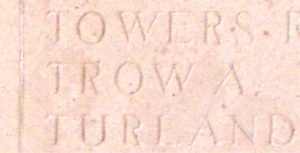
Richard Edward Williams, Private, 64375, Welsh Regiment. Richard was the son of William and Jane Williams, Rhallt, Berriew. By 1911 the family had moved to 5, Sergeants Row, Welshpool, where Richard became an Apprentice Baker. Richard enlisted into the 63rd Training Reserve Battalion at Welshpool on 17 October 1916, and was posted to Kinmel Park for training. On 18 January 1918 Richard embarked for France, and was sent to No 5 Infantry Base Depot at Rouen. On 18 February 1918 he joined the 9th Battalion, Welsh Regiment, which attached to 58 Brigade, 19th (Western) Division, and was near Bancourt, facing the Hindenburg Line. By the time Richard arrived, the 9th Welsh had been relieved and was in a rest camp at Rocquigny, carrying out a system of training and enjoying inter-company sports. The battalion then moved to Phipps Camp, Haplincourt, to carry out more training, remaining there until 21 March, remaining at ‘Stand To’ due to rumours of an impending German offensive. At 04.45 the peace was broken by an intense artillery bombardment along the entire section of front running from nearby Croisilles south to La Fère, so the 9th Welsh was Stood To, before receiving orders to advance to Gaika Copse. The Germans had by now attacked the front line with highly trained stormtroopers, and had broken through in many places. By 14.00 the 9th Welsh had moved into the main battle area, to support the remainder of the 19th Division, and also to support the beleaguered 51st (Highland) Division at the Hermies Switch Line. Richard had not even been in a front-line trench yet, but had now been plunged into the fiercest and most important battle of the entire war. By the morning of 22 March, the 9th Welsh had been forced to side-step before taking over defensive positions in front of the village of Beugny, and prepared to hold the village to enable the remainder of the division to retire to safety. At 10.30 on 23 March the Germans began to launch a series of attacks against the village, breaking through the northern edge of the village by the afternoon. Heavy fighting raged throughout the day, before the 9th Welsh was forced to withdraw to a new defensive line overnight. Richard had been posted missing on 23 March 1918 and was afterwards confirmed as having been killed in action on that date. He was originally buried in a mass grave on the battlefield, but after the war the grave was exhumed, and eight sets of remains were carefully removed. Only one set of remains, those of Richard’s, were identified, as he still had his ID tag, and he was re-interred in Bancourt British Cemetery, France. Richard is not commemorated on the Berriew war memorial, but at nearby Welshpool. His brother, William, was killed later that year.
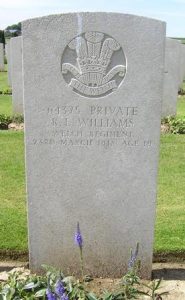
William Williams, Private, 54672, Royal Welsh Fusiliers. William was the son of William and Jane Williams, Rhallt, Berriew. By 1911 the family had moved to 5, Sergeants Row, Welshpool, where William worked as a Waggoner. William enlisted into the 7th Battalion, Royal Welsh Fusiliers at Welshpool, and after completing his training, was posted to France in the summer of 1916, joining the 16th Battalion, Royal Welsh Fusiliers, which was attached to 113 Brigade, 38th (Welsh) Division. He probably joined the battalion after its withdrawal from the Somme sector, following the Division’s assault on Mametz Wood in July. The Division then took over a section of the front at Hébuterne before moving to the Ypres Salient, and taking over the Canal Bank sector at Boesinghe. The infantry battalions of the Division then began carrying out the normal pattern of rotation in the trenches, four days in the front, four in support and four in reserve, whilst also working on trench improvement, digging new trenches, and also carrying out regular patrols and trench raids. On 31 July 1917 the Division launched its famous assault on the Pilckem Ridge, capturing Iron Cross and reaching its objective of the Steenbeek, then played a supporting role in the Battle of Langemarck. The Division was transferred to the Sailly-sur-la-Lys sector in September, and remained in the area over the winter before being moved to positions north of Albert, at Bouzincourt Ridge, at the end of March 1918, relieving the battered 2nd and 47th Divisions. It held this sector, again carrying out minor operations and trench raids, over the coming months, before taking part in the great offensive of 21 August 1918, and began its advance towards the Hindenburg Line. By now, William had been transferred to the 2nd Battalion, Royal Welsh Fusiliers, which was attached to 115 Brigade, in the same 38th (Welsh) Division. By 13 October the Division had reached the River Selle, and began preparations to launch an assault across it. William was killed in action here on 16 October 1918. The 24-year-old is buried in Montay-Neuvilly Road Cemetery, Montay, France. William is not commemorated on the Berriew war memorial, but at nearby Welshpool. His brother, Richard, had been killed later that year.
William Frederick Williams, Private, 3710, Royal Welsh Fusiliers. William was the son of David and Jane Williams, of Fron, Garthmyl. He worked as a Waggoner prior to the war. William enlisted at Newtown into the 7th Battalion, Royal Welsh Fusiliers. The battalion was a Territorial unit, which mobilised for war at Newtown in August 1914, as part of North Wales Brigade, Welsh Division and moved to Conway until the end of the month, before moving to Northampton. In December the Division moved to Cambridge and then in May 1915 to Bedford, where the Division was numbered and the formation became 158 Brigade, 53rd (Welsh) Division. On 19 July 1915 the entire Division sailed from Devonport for Imbros and on 9 August 1915 landed at Suvla Bay. The infantry moved off the beaches into the bush, but due to a lack of maps and no knowledge of the terrain, many of the units became disorientated, and the situation became chaotic. William was killed in action during heavy fighting on the following day, 10 August 1915. The 31-year-old has no known grave and is commemorated on the Helles Memorial, Gallipoli.
World War Two, 1939-1945
John Wilson Ashley, Driver, 2339882, Royal Corps of Signals. John was born on 5 January 1908, the son of Edward and Lucy Ashley, of Little Dollas, Berriew. He married Lilian Louisa Poppitt, of Lea Cross, Shropshire in 1929. Following the outbreak of war, John enlisted into the Royal Corps of Signals and was posted to X Corps Signals. X Corps, which comprised two armoured divisions, first went on active service in Syria, then in the summer of 1942 joined the Eighth Army in Egypt. X Corps fought the Second Battle of El Alamein, helping defeat Rommel’s Afrika Korps and fought in the Tunisian Campaign until the German surrender in Tunisia in May 1943. The Corps did not take part in the Sicily campaign but took part in the landings at Salerno, as part of the US Fifth Army, on 9 September 1943. Following the eventual break-out from Salerno, X Corps took part in the advance up the west of Italy, breaching the Volturno Line and took part in the first Battle of Monte Cassino in January 1944. John died as a result of an accident in Italy on 3 January 1944. The 36-year-old was originally buried in an isolated grave, but in September 1944 his remains were exhumed and he was re-interred in Naples War Cemetery, Italy.
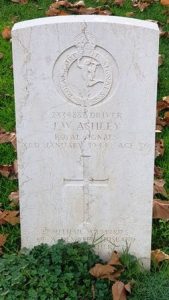
William David John Harper Ball, Flight Sergeant, 1183351, Royal Air Force Volunteer Reserve. William was born in 1922, the son of Samuel Harper Ball and Katharine Irene Ball (nee Fullalove), of Berriew. His father had served in the Coldstream Guards during the Great War, then became a schoolteacher after being demobilised, and the family had spent several years overseas, in Singapore, prior to the war. William enlisted into the Royal Air Force Volunteer Reserve, and trained as a Pilot before being posted to 223 Squadron, RAF. After the entry of Italy into the war, the squadron, based in Sudan, flew bombing missions against Italian forces over Italian East Africa. The squadron moved to Aden in August 1940, and in April 1941 moved to Egypt, becoming an Operational Training Unit (OTU), converting aircrews onto a variety of twin-engine bombers. The squadron then equipped with the Martin Baltimore bomber, and supported the Eighth Army in the North Africa campaign. On 19 September 1942, William was flying Baltimore II, Serial AG893, when it collided with another Baltimore of the same unit and crashed into the desert, killing both crews. William, who was 20 years old, was originally buried with his four crewmen in El Alamein, and on 10 March 1944 their graves were exhumed, and their remains re-interred in El Alamein War Cemetery, Egypt.
Donald Herbert Lloyd, Aircraftman 2nd Class, 2335879, Royal Air Force Volunteer Reserve. Donald was born in 1928, the son of Herbert Richard Lloyd and Gertrude Elizabeth May Lloyd (nee Evans), of Fron Lomond, Garthmyl. He enlisted into the Royal Air Force Volunteer Reserve after the end of the war and was posted to 4238 Servicing Echelon at Abingdon. Donald later took ill and died in Shrewsbury Hospital on 1 March 1947. The 18-year-old was buried in St. Beuno’s Churchyard, Berriew. Donald is not commemorated on the Berriew War Memorial.
George Seymour Lloyd, Trooper, 14552277, Royal Armoured Corps. George was born in 1925, the son of Charles Edgar Lloyd and Annie Mary Lloyd (nee Williams), of Red Gates, Garthmyl. He enlisted into the army as soon as he turned 18, and was posted to the 141st Regiment, Royal Armoured Corps, an armoured unit which had been raised in November 1941 by the conversion of the 7th Battalion, The Buffs (Royal East Kent Regiment). The regiment, armed with Churchill Crocodile tanks, landed on the beaches of Normandy in June 1944 as part of the 79th Armoured Division, and saw heavy fighting during the Battle of Normandy, in support of the 53rd (Welsh) Division and after a brief rest and refit at the end of August took part in the subsequent drive northwards through Northern France towards Belgium. George was killed in action during the drive towards Calais, on 18 September 1944. The 19-year-old was originally buried on the battlefield, alongside Trooper Brailsford, who had been killed with him, but in August 1945 their graves were exhumed, and the two men were buried in Calais Canadian War Cemetery, Leubringhen, France.
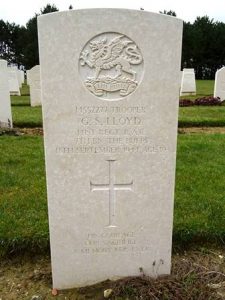
Douglas Norman Powell, Sergeant, 533840, Royal Air Force. Douglas was born on 22 May 1917, the son of John Powell and Harriet Millicent Powell (nee Evans), of Church terrace, Berriew. He enlisted into the Royal Air Force as a young man and after completing his training as a Flight Engineer was posted to 83 Squadron, Royal Air Force, which was based at RAF Wyton. On the night of 20 December 1942, Douglas took off from Wyton aboard an Avro Lancaster I, Serial ED353, as part of a large number of bombers despatched to hit targets in Duisberg. The Lancaster was hit by flak near to the target area and crashed at Duisburg-Wedau on the following morning, 21 December 1942, with the loss of all her crew of seven men. The bodies of Douglas and his fellow crewmen were recovered by the Germans and buried in Düsseldorf Northern Cemetery, but in November 1946 their graves were exhumed, and the men were buried in Reichswald Forest War Cemetery, Germany.
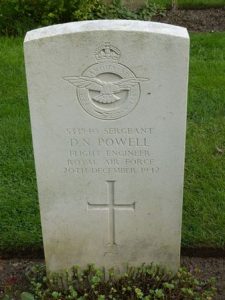
Philip Roberts, Sergeant, 1511208, Royal Air Force Volunteer Reserve. Philip was born on 31 May 1921, the son of Ann Roberts, of 2, Plas-Llwyn, Berriew. He was raised by his grandmother Mary and had trained as a carpenter prior to the war. Philip then enlisted into the Royal Air Force Volunteer Reserve and after completing his training as a Flight Engineer was posted to 106 Squadron, RAF, which was based at RAF Syerston. On the night of 5 September 1943, Philip took off from Syerston aboard an Avro Lancaster I, Serial W4922, which joined a large bomber force despatched to strike targets in Mannheim. During the early hours of 6 September 1943, the Lancaster crashed into the River Rhine at Ludwigshafen, killing all her crew of seven men. The remains of the men were recovered by the Germans and buried in Ludwigshafen Civil Cemetery, but in October 1947 their graves were exhumed and the men were re-interred in Durnbach War Cemetery, Germany.
Stanley Francis Shuker, Fusilier, 4195662, Royal Welch Fusiliers. Stanley was born in 1920, the son of Robert Shuker and Ann Shuker (nee Reggins), of Cross Lane Cottage, Berriew. He was a regular soldier, serving with the Royal Welch Fusiliers, and embarked for France with the BEF, being attached to the Auxiliary Military Pioneer Regiment, Pioneer Corps, which had been formed from Army Reservists. Following the launching of the German Blitzkrieg, Stanley’s unit was pressed into service as infantry, before withdrawing to the French coast for evacuation. The thousands of troops who had made it to Dunkirk had already been evacuated by 6 June, whilst more had been evacuated from Boulogne, Calais and Le Havre by 25 May. More Allied troops had managed to reach ports in other parts of France, stretching from Cherbourg down to Bayonne, so the British organised Operation Aerial, to evacuate Allied forces and civilians from western France. Stanley had managed to reach St. Nazaire with most of his company. On 17 June 1940 the requisitioned RMS Lancastria steamed into the Loire Estuary and anchored in the Charpentier Sounds. By the afternoon Lancastria had taken aboard a huge number of evacuees, far greater than she was built to carry, with estimates running from 4,000 to 9,000 people. The Germans had already begun attacking shipping in the area, and at 15.50 Lancastria was attacked by Junkers-88 bombers and sank in less than 20 minutes. An estimated 6,500 people drowned in the sinking of Lancastria that day. Stanley was 20-years-old when he died as a result of the sinking of the Lancastria that day. His body was later recovered and he was buried in La Bernerie-En-Retz Communal Cemetery, France. His brother, George William Shuker, had been serving with 84 Squadron, RAF in the Far East by 1940, and had been captured by the Japanese, spending the war in PoW camps.
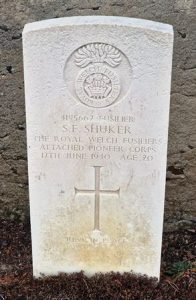
Idris Emlyn Smith, Lance Corporal, 4194607, Royal Welch Fusiliers. Idris was born in 1914, the son of Richard Parry Smith and Sarah Jane Smith (nee Caswell), of Pen-Llwyn, Berriew. He had followed in his fathers footsteps and enlisted into the 7th Battalion, Royal Welch Fusiliers, the local Territorial Army battalion, which was attached to 158 Brigade, 53rd (Welsh) Division. The battalion was mobilised at the outbreak of war, when the Division moved to Northern Ireland to begin garrison duties. The Division then moved to Pembroke Dock, before moving again to the south of England, where it trained in readiness for the D-Day Landings. Idris married Florence Marion Beatrice Davies whilst on leave in the spring of 1944. On 24 June 1944 the 7th RWF left England for Normandy, and landed at La Riviere near Ver Sur Mer. The Division then took part in heavy fighting over the coming weeks, as part of the effort to break-out of the Normandy beach-head, seeing heavy fighting at Évrecy, before starting the epic advance through Northern France and on the night of 2 September had crossed the River Somme. After crossing the bridge the 7th RWF was sent to Domart-En-Pontheim via Vignacourt, and on the morning of 3 September 1944 encountered a party of Germans at Brucamps. Idris and a fellow Fusiliers, Harold Thomas, were killed in the fighting which ensued. Idris was 30 years old when he was killed that day, and is buried besides Harold in Brucamps Communal Cemetery, France.
Charles Tanner, Gunner, 4195138, Royal Artillery. Charles was born at Berriew in 1918. He enlisted into the Royal Artillery and was posted to the 1/1st Maritime Regiment, Royal Artillery, where he trained to be a Merchant Navy Gunner. Charles was then posted aboard the Merchant Steamer SS Sabino, which was owned by Ellerman & Papayanni Lines Ltd, Liverpool. At the end of September 1941, Sabino left Mombasa, carrying a cargo of sisal and general stores, joining Convoy SL-89. The convoy reached Freetown on 5 October, before steaming for Liverpool. On 21 October 1941, the convoy was west of Fastnet when it was attacked by the German submarine U-82. Serbino was hit amidships by a torpedo fired by the submarine and sank with the loss of eleven crewmen and three gunners. Charles was 23 years old when he was killed during the sinking of Serbino that night. He has no known grave so is commemorated on the Portsmouth Naval Memorial, Hampshire.
